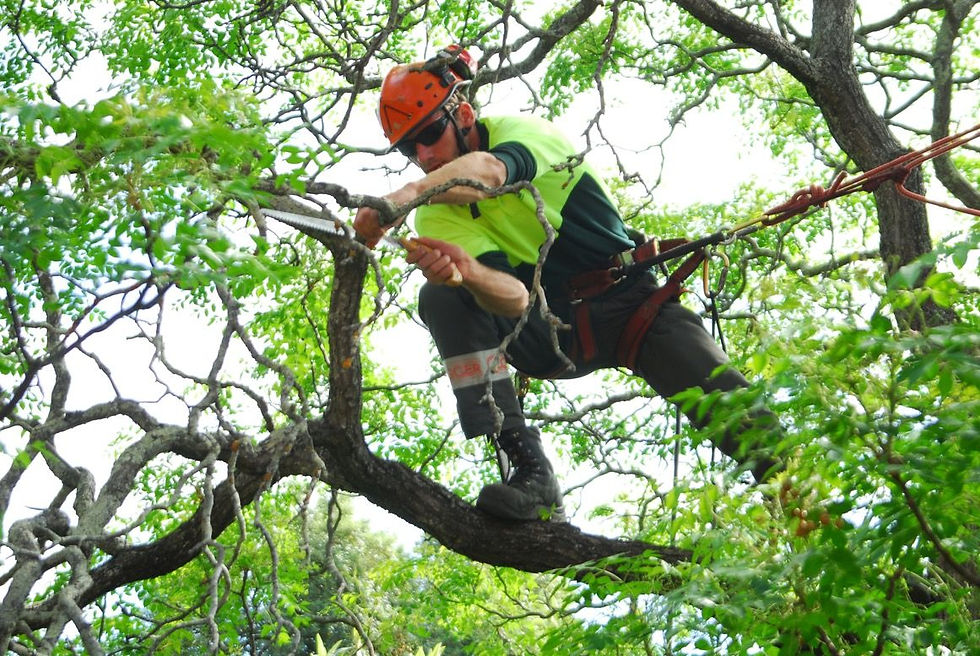9 Warning Signs Your Tree May Be Dying (And What to Do About It)
- treeguys44
- May 22
- 4 min read
Trees are one of the most valuable and beautiful parts of your landscape, but when one starts to decline, it can quickly become a serious safety hazard. A dying tree isn't just a risk to your curb appeal, it can also fall unexpectedly, causing damage to your home, vehicles, or worse.
1. Persistent Branch Shedding

Healthy trees don’t regularly drop branches or twigs. When you begin to notice an unusual amount of small or large branches littering the ground, especially without any strong winds or storms to blame, it could be a sign of internal stress or decay.
This kind of breakage often indicates that the tree’s limbs are becoming brittle and weak, which usually means it's not getting the nutrients it needs.
2. Peeling, Cracked, or Missing Bark

Think of bark as a tree’s outer layer of protection. When it starts to peel, crack, or fall off in large sections, that tree is likely under stress. Bark loss may result from disease, insect infestation, or environmental damage.
You can gently check for underlying health by doing a scratch test: lightly scrape off a small patch of outer bark with a knife or your fingernail. If the inner layer is green and moist, the tree may still be alive. If it’s dry and brown, the tree could be dying.
3. Fungal Growth or Rotting Wood

Some obvious signs a tree is dying is fungal infestation. Fungus around the base of a tree or along the trunk often signals internal decay. Trees that develop soft, spongy wood, large cavities, or visible mushrooms are typically dealing with a deeper root or trunk problem that may not be reversible.
Fungi thrive on decomposing organic matter, so when they appear on a tree, it’s usually because parts of it are already dead or dying. Depending on the extent of the damage, removal may be the safest option.
4. Leaning or Shifting Posture

Trees don’t typically start leaning unless something underground has changed, often the root system. Sudden leaning may suggest that the roots have been damaged, rotted, or compromised, making the tree unstable and at risk of falling.
While minor leaning may be corrected with bracing or cabling, a significant shift requires immediate attention from a tree care professional.
5. Sparse or No Foliage

One of the clearest indicators of a dying tree is a loss of leaves, especially during the growing season. If a tree has little to no foliage, or if one side is bare while the other appears normal, that asymmetry may suggest root damage, disease, or pest infestation.
Keep an eye out for:
Leaves that appear smaller than usual
Discoloration (yellowing or browning)
Dead leaves clinging to branches deep into winter
These signs indicate that the tree is no longer able to circulate water and nutrients effectively.
6. Pest Infestations

Insects like termites, beetles, borers, and carpenter ants can wreak havoc on tree health. These pests burrow into the bark, feed on internal wood, and leave behind exit holes, sawdust, or frass (insect waste).
Once pests take hold, especially in a tree already weakened by other factors, they can accelerate its decline. Left unchecked, infestations can also spread to nearby trees or even your home.
7. Dead or Brittle Branches

When large branches are dry, brittle, and easily snap with little pressure, it typically means that part of the tree is no longer alive. While deadwood can be pruned to help the tree focus energy on healthy growth, excessive dead branches often point to a larger issue at the trunk or root level.
Pro tip: If more than 50% of the branches are dead or damaged, the tree may not be recoverable.
8. Root Damage or Soil Heaving

A tree’s root system is its foundation, and when it's compromised, the tree is in danger. Root damage can occur due to nearby construction, trenching, changes in soil grade, or even drought conditions.
Signs of root problems include:
Exposed roots
Soil heaving (bulging soil near the base of the tree)
Sudden leaning or instability
Lack of growth during the growing season
Because root issues often go unseen, changes at ground level should never be ignored.
9. No Green Under the Bark (The Scratch Test)

A simple and reliable check: scratch a small section of bark with your fingernail or pocket knife. If it’s green underneath, your tree still has some life. If it’s dry, brown, and brittle, the tree may be dead or very close to it.
Combine this check with other symptoms, like leaf loss, fungus, or pests, for a more complete picture of your tree’s condition.
When You See Signs a Tree Is Dying, Call In Experts
If your tree is showing any of these warning signs, don’t ignore them. Waiting too long could put your home—and your safety—at serious risk. The certified team at Tree Guys Tree Services can assess your tree’s condition, explain your options, and handle everything from treatment to removal.
Our licensed professionals are trained to spot early warning signs and offer honest, expert guidance for Media, Pennsylvania and the surrounding area. Whether your tree needs pruning, treatment, or removal, we’ve got your back (and your backyard). Contact us today for a professional assessment and a free quote.
📞 Call us now 484- 309-5986
🌐 Visit treeguystreeservices.com
📍 Serving Chester & Delaware Counties



Comments